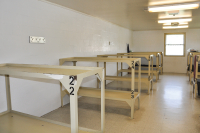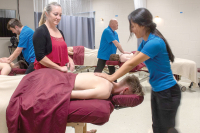Recession rebound: turnaround in progress at Harrah’s Cherokee Casino
After inching its way back from recession-driven declines during the past year, Harrah’s Cherokee Casino and Hotel is back in the catbird seat.
You could even call it a Royal Flush. The advent of live dealers and table games coincides with a $633-million transformation of the casino into a rollicking resort.
Those two things have positioned the casino to recover from a bothersome slowdown in gaming revenues that spanned three years from 2008 to 2010.
At its low point, operating revenue in 2010 dropped from its pre-recession highs of $445 million to $385 million.
Harrah’s was hardly alone. Casinos nationally saw a downward trend during the recession. And like Cherokee, they are now seeing signs of improvement.
“Many markets are starting to see a slight uptick, but nothing to start pounding our chest about,” Harrah’s Cherokee Brooks Robinson said.
Related Items
Robinson isn’t ready to celebrate until the casino is back to its pre-recession gaming revenue.
“It was a minimal, minimal increase,” Robinson said of last year. “We are not seeing any of this double-digit kind of growth we had hoped for.”
Stacking up
Cherokee’s decline in gaming revenue was bigger and persisted longer than losses seen elsewhere in the casino industry, according to Casino City’s annual Indian Gaming Industry Report released earlier this year.
In fact, North Carolina posted the largest declines in gaming revenue compared to other states with tribally run casinos.
North Carolina Indian tribes’ gaming revenue declined by 3 percent in 2008, 9 percent in 2009 and 6 percent in 2010, according to the industry report. Cherokee is the only gambling establishment in the state — and thus the lone entity reflected in those numbers.
Meanwhile, tribally run casinos nationally saw a decline of only 1 percent in 2009 and leveled off in 2010.
Cherokee’s declines perhaps are more pointed compared to Indian gaming elsewhere because its gains in the proceeding years were so impressive. It had nowhere to go but down.
Granted, an off year for Harrah’s is still amazingly profitable. It is one of the biggest and most profitable Indian-run casinos in the nation. Revenue-wise, it is in the top 5 percent of casinos run by tribes.
Even in 2010 — the low point after three years of declining gaming revenues — profits were still $209 million. With $385 million in operating revenue, that puts its operating profit margin at more than 50 percent in 2010, according to financial numbers contained in an economic impact analysis of the casino conducted by the UNC School of Business.
Setting the stage
For Harrah’s Cherokee, though, the gaming revenue is only part of the picture. Unlike many Indian-run casinos that are little more than a cavernous slot parlor, sporting sprawling gaming floors and little else, Cherokee has made itself into a destination resort.
Three hotel towers, making it the largest hotel in the state of North Carolina, a major big-act performance venue, a litany of restaurants and lounges, retail shopping, and soon a spa mean the casino is not dependent only on gaming revenue.
“With all these non-gaming amenities they have been adding that definitely can become a source in and of itself. The nongaming revenue can become a very large part of the revenue generated by the casino,” said Alan Meister, principal economist with Nathan Associates, which conducts the Indian Casino Gaming Industry Report.
Revenue from the non-gaming side may have grown enough to offset the full impact of the declines on the gaming side, Meister said.
The resort-style casino Cherokee has created gives it a tremendous advantage coming out of the recession, particularly compared to other Indian-run casinos.
Tribally operated casinos saw a bigger decline than the big gambling centers like Vegas, the Gulf Shore or Atlantic City. Primarily because they don’t have as much to do.
“Indian gaming has been hit harder, and it has been slower to recover,” said Meister. “For a lot of Indian casinos, they have not been able to replicate the amenities of commercial gambling destinations.”
Cherokee has, however. Not only in the restaurants, nightlife and shopping concourse contained in its sprawling campus, but its multiple gaming floors, each with different themes, decors and feels, replicate the feeling of “casino-hopping” that players get when visiting gambling strips in Vegas or the Gulf Coast.
The resort amenities also have a “feedback effect” for the gaming side of the operation, Meister said. They can attract more guests and get them to stay longer — both of which mean more casino play.
Calculated risk
The winning hand Cherokee is emerging from the recession with wasn’t luck. Cherokee executed a series of calculated plays to get where it is.
On one front was the long-sought, hard-fought battle with top state lawmakers to allow live dealers and table games like poker and roulette. It took a decade of negotiating and lobbying to win the state over — not to mention a little sweetening of the pot with a promised cut of the profits off the new games, albeit a token 4 to 8 percent.
Meanwhile, the tribe embarked on a major reinvention of the casino.
The expansion has already been paying off as new pieces come online — a doubling of the gaming floor, a third hotel tower, an array of new restaurants and lounges, retail shops, a major concert venue. It also convinced the tribe to allow alcohol at the casino, which was previously dry.
Harrah’s Cherokee General Manager Brooks Robinson credits the improvements with helping to reverse a decline in profits.
“I think the big question we are asked a lot is where would we be if the tribe hadn’t had the forethought of investing in building what we have today,” Robinson said.
While the tribe hired Harrah’s to run and manage daily operations of the casino, the Cherokee play an active role — including in the long-range vision for its transformation.
“They are very interested in the business and take a lot of pride in the property. They want to turn it into a true destination,” Robinson said.
Gaming to boost per cap checks (eventually)
The advent of live dealers and table games is likely welcome news for members of the Eastern Band of Cherokee Indians. The better the casino does, the more money they get.
A portion of casino profits is shared among the tribe’s enrolled members, known as the “per cap” distribution.
While the new table games will undoubtedly bring more revenue for the casino, it won’t show up in per cap checks immediately, however, due to upfront costs in bringing the new games online, like hiring 500 new employees and buying equipment.
Tribal members saw their per cap checks go down during the recession as profits declined at the casino. Per cap distribution isn’t back to pre-recession levels but is now moving in the right direction.
Per cap checks issued for the first half of this year were 8 percent higher than this time last year — and 2011 was 8 percent higher than 2010.
The checks sent this June were $3,785 compared to $3,506 in June 2011. Per cap checks are sent out twice a year in June and December.
The tribe’s profits have fluctuated between $210 million and $225 million in recent years. Half goes to support tribal programs — from education to health care to quality-of-life amenities, like a movie theater, a golf course and skate park. The other half of casino profits is split among the tribe’s 14,000 enrolled members.









